| Interview John E. Abele, Part I |
||
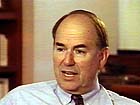 John E. Abele, Founder Chairman of Boston Scientific Corporation,
began his involvement with the field of minimally invasive medicine
over three decades ago. He first became involved with Andreas Gruentzig
in 1974, and subsequently worked with him in the early days of angioplasty.
Today Boston Scientific Corporation is a worldwide leader in the manufacturing
of devices for interventional cardiology and radiology. This interview
was conducted in October 1996 by Burt Cohen.
John E. Abele, Founder Chairman of Boston Scientific Corporation,
began his involvement with the field of minimally invasive medicine
over three decades ago. He first became involved with Andreas Gruentzig
in 1974, and subsequently worked with him in the early days of angioplasty.
Today Boston Scientific Corporation is a worldwide leader in the manufacturing
of devices for interventional cardiology and radiology. This interview
was conducted in October 1996 by Burt Cohen.
(Click here to access index of previous interviews.) 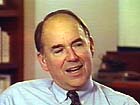 Q: How and when did you first hear of angioplasty?
Q: How and when did you first hear of angioplasty?Abele: The first time I heard of angioplasty was probably two or three years after Dotter published. No...it might have even been that Life Magazine article, so I take it back. It was actually '64 because there was the Edsel ad opposite Dotter, and there was something symbolic in that. I always enjoyed that — that always stuck in the back of my mind. I was already in the medical business at the time and worked with Earl Bakken, who was the founder of Medtronic. And when he had his little green garage in 1960, I was actually working for a little manufacturer in Boston. So I've had the dubious distinction of going to, if not every one, almost every American Heart meeting since 1960. 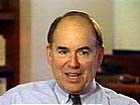 And it's been interesting to watch the evolution not only of technology,
but the way in which people look at technology: what it can do; how
do you assess it; how do you determine whether it's good or bad; how
do you look for risks; how do you train people. There's been a gradual
evolution in that and angioplasty was an interesting concept, but
looked at sort of as a UFO by the medical community generally. Sort
of a far out thing that was intriguing, but really didn't apply to
real world medicine.
And it's been interesting to watch the evolution not only of technology,
but the way in which people look at technology: what it can do; how
do you assess it; how do you determine whether it's good or bad; how
do you look for risks; how do you train people. There's been a gradual
evolution in that and angioplasty was an interesting concept, but
looked at sort of as a UFO by the medical community generally. Sort
of a far out thing that was intriguing, but really didn't apply to
real world medicine.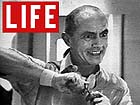
 And if you remember the Life Magazine article, Dotter was made
to look like an alien, and somehow didn't consider editing the pictures
himself.
And if you remember the Life Magazine article, Dotter was made
to look like an alien, and somehow didn't consider editing the pictures
himself. Q: You actually started work on a catheter? Abele: At that point bypass surgery was getting more and more publicity, and it sort of made sense that, if you could do it with a catheter, there would just be enormous benefit. I had met Dick Myler at that time and we had talked and speculated about things that could have a big impact in the field and we showed him some of the ideas and concepts we had at our little company called Medi-Tech for doing what we called catheter endarterectomy — where you'd simply remove the debris from the heart with a catheter. 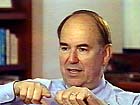 Dick had been interested in that and we actually made some devices...basically
a guide wire with a reversing Chinese finger puzzle mesh, so instead
of pulling it and making it smaller, you push it and make it bigger.
And you have an expanded mesh, not unlike a stent, as a matter of
fact — only this was 1970.
Dick had been interested in that and we actually made some devices...basically
a guide wire with a reversing Chinese finger puzzle mesh, so instead
of pulling it and making it smaller, you push it and make it bigger.
And you have an expanded mesh, not unlike a stent, as a matter of
fact — only this was 1970.In the meantime I had, in my travels all over the world, kept asking people what they knew about the concept of treating coronary arteries with a catheter instead of with surgery. And one of those incidents was calling up Dotter, and calling up Mason Sones, father of coronary angiography, and another fellow, named Bill Hannify who was at UCLA at the time, and asking each of them if they had ever poked a guide wire down deep into the coronary artery as a means of passing a lesion. And each one of them said "No", but they were sure that the other two had. So I was convinced they all had, and it was a "don't ask, don't tell" kind of a mind set. And I think that was really the limitation on doing innovation. Not only in cardiology but in any of the fields. If you took on something really dramatically different, you risked the opprobrium of the community at large, not only your own specialty, but others as well. So it took enormous guts to do something new and different. 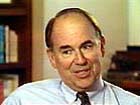 Q: When did the balloon concept happen?
Q: When did the balloon concept happen?Abele: Long about that time, we got some correspondence from Martin Kaltenbach in Frankfurt. He spoke to us about a catheter that he wanted to have built, which was a catheter with a balloon at the tip. I later learned, of course, that Kaltenbach had met with Gruentzig and this was really that concept of using a balloon. Then in 1974, I got a letter from our agent in Switzerland who, referring to Dr. Gruentzig, said he was very interested in seeing if we had a steerable catheter through which a smaller catheter could be passed. What he was looking for was a way to guide a coronary dilatation catheter into the coronary artery reliably. Gruentzig had sent me a model of a guiding catheter made out of Teflon with a wire attached, and when he saw our steerable catheter where the wires were neatly built into the wall, he said this is clearly the sort of thing that we need. So we sent him some of those catheters and I went over and visited him in 1975. At that time he was living in his apartment in Zurich and his wife was a psychologist and actually had patients come to their apartment. And so while she was counseling with a patient in one room, Andreas and I were talking in another. But we had to obviously keep the noise down. And he showed me where he made his catheters in his kitchen, and I took one look at how he was making his catheters and you had to marvel at it, because he took single lumen tubing and in order to get two lumens into the catheter, he would put a sheath over the outside. The first lumen was on the inner tube and the second lumen was in that space in-between. The problem had been, if he applied suction, it would tend to collapse the outer sheath. In order to prevent that sheath from collapsing, he took a razor blade and went all the way down the catheter twice making a "V" groove. Which is, if you've ever tried that, more than tricky to do than brain surgery, to say the least.  I said, "Andreas, don't you know that you can get two lumen catheters?"
And he hadn't heard of two lumen catheters. He said he had asked and
people said they didn't exist. So I said, "Well, we make them!" As
a result of that, Andreas came over and visited us in Watertown, near
Boston, and we actually spent time on the extruder. In fact, Andreas
ran the extruder. He was a very hands-on sort of person and loved
that feel.
I said, "Andreas, don't you know that you can get two lumen catheters?"
And he hadn't heard of two lumen catheters. He said he had asked and
people said they didn't exist. So I said, "Well, we make them!" As
a result of that, Andreas came over and visited us in Watertown, near
Boston, and we actually spent time on the extruder. In fact, Andreas
ran the extruder. He was a very hands-on sort of person and loved
that feel.In fact, although this is an aside, it's an interesting aside. We had spent a weekend on Cape Cod and I had bought a windsurfer. This was 1975 now, and I taught him how to windsurf. And he just basically learned in about 30 minutes and was up sailing in 20 knot winds — just incredible! Very, very athletic person. So, he was a quick take and we made some two lumen catheters for him. We had trouble sticking the balloons onto the shaft and that was a problem. But try as we might we never got a level of catheter at that time, that really met the criteria for human use. In the meantime, he had gone with Schneider in Zurich, and Schneider was a needle manufacturer, and he basically helped them to learn how to make balloon catheters.  And so, it was not only the design, but it was actually in the manufacture
that he participated. And sort of unusual for a physician inventor,
he sort of oversaw all the production as well. So no catheter went
out that he hadn't reviewed and nobody received a catheter whom he
hadn't reviewed. He checked the customer and he checked the manufacture.
And I think that contributed to the control of the development of
the process. Again, you don't see that very often. It was hard for
somebody else to make these balloons. These were very technically
difficult with the technology that existed at the time. There were
others who saw the concept and tried, but they were not effective.
And so, it was not only the design, but it was actually in the manufacture
that he participated. And sort of unusual for a physician inventor,
he sort of oversaw all the production as well. So no catheter went
out that he hadn't reviewed and nobody received a catheter whom he
hadn't reviewed. He checked the customer and he checked the manufacture.
And I think that contributed to the control of the development of
the process. Again, you don't see that very often. It was hard for
somebody else to make these balloons. These were very technically
difficult with the technology that existed at the time. There were
others who saw the concept and tried, but they were not effective.
Part II: John Abele's interview continues with Gruentzig's first presentation at the AHA and the subsequent development of PTCA. Back to current "Featured Interview" Go to Interview Index |
||
| |
||
|
Angioplasty.Org Home • PatientCenter send comments & suggestions
to "info at angioplasty dot org" |
||